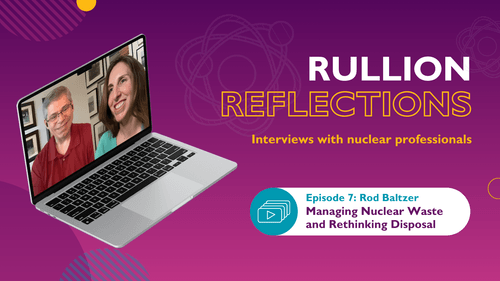The Future of Nuclear talent with Nancy Bellingan
Whether it was standing out as the only girl in a physics class of 20 in Italy or driving across Europe to begin a new role in the UK, Nancy Bellingan has built her career by embracing challenges head-on. In episode 6 of Rullion Reflections, Nancy explores the future of nuclear. She explains why education, visibility, and breaking down barriers are just as important as technology in shaping the next generation of nuclear talent.
Watch the full Rullion Reflections Ep. 6 interview with Nancy or read on for the key highlights from the conversation.
At the cutting edge with Createc
Today, Nancy brings her experience to Createc as a Radiation Physicist. Known for pioneering work in nuclear decommissioning, robotics, and 3D radiation mapping, Createc is the kind of environment where no two days look the same.
Her journey to the role was as memorable as the work itself. Packing up her life in Germany, she carefully measured her small car to make sure every box would fit, then drove across Europe, through Belgium and the Channel Tunnel, before finally arriving in Cumbria. “It was completely full – I couldn’t have squeezed in another thing,” she laughs.
Nancy first connected with Createc at DigiDecom, a digital decommissioning conference, where she was struck by the company’s innovative spirit and by the leadership of Rosie, now one of her colleagues. That chance meeting led to an opportunity, and Nancy quickly knew it was the right fit.
“They replied within an hour of my application and offered me the job the next day. That efficiency really stood out, and once I started, I didn’t know I could like a job this much. No two days are ever the same.”
Early Inspiration
Nancy’s interest in science began early. Growing up in Italy, she often followed in her brother’s footsteps; whether it was rugby, scuba diving, or computer games. When he became interested in nuclear, so did she. But it was role models like Licia Troisi, an astrophysicist and fantasy author from her hometown, who showed her what was possible.
“I wanted to be like her: an astrophysicist who also wrote books,” Nancy recalls. “In the end, I only did one part: the nuclear physics.”
That mix of curiosity, role models, and resilience meant that being “the only girl in the class” never discouraged her. Instead, it became part of her drive.
Nuclear education as the foundation
Nancy believes it all begins in the classroom. Too often, the first time young people hear about nuclear is through disasters or sensationalised media. These historic events must not be forgotten, but they should be understood in context, alongside decades of progress in safety, innovation, and regulation that make the nuclear industry what it is today.
Nuclear today is one of the most heavily regulated and scrutinised energy sectors in the world, monitored by organisations like the IAEA, ENSREG, and the ONR in the UK, with multiple layers of safety protocols in place to minimise risk.
Early nuclear education is one of the best ways to reshape understanding. By introducing nuclear concepts in school science classes, students can see how nuclear is used today as a clean energy source and through its life-saving medical applications. In countries like Belgium and France, nuclear is woven into environmental studies from a young age, creating a more balanced foundation where nuclear is part of education; students grow up seeing it as normal, not controversial.
For example, Belgium’s parliament recently voted to drop the phase-out of nuclear energy, extending reactor lifetimes and exploring new builds. And in 2025, France will generate nearly 70% of its electricity from nuclear power.
This early education not only helps to shift public opinion but also to show students the vast opportunities available in nuclear careers, helping to bring in the next generation of nuclear talent.
Attracting and retaining future of nuclear talent
“How can we get more young people into the nuclear industry?” Sibel asks.
The irony, Nancy points out, is that even when students choose nuclear pathways, many find the doors closed. Security clearance, nationality restrictions, and slow recruitment processes often block skilled candidates from entering.
The result is bright minds drift into other industries, while nuclear struggles to fill the pipeline it desperately needs.
Nancy sees the cost of this up close: graduates with the right skills and passion who simply can’t find a way in. It’s not that the talent isn’t there; it’s that the system is too rigid to welcome them. And every missed opportunity is another gap in research and development, another idea never explored, another innovation lost.
"I have so many former students who studied nuclear-related subjects and they’re not getting jobs. It’s not that they don’t want to join, it’s that sometimes they’re not let in."
To sustain the future of nuclear talent, the industry must turn inspiration into opportunity. That means breaking down barriers, making hiring fit for purpose, and showing students clear and diverse career paths. Without young professionals in the labs, in R&D, in decommissioning, and in innovation, nuclear risks losing momentum in the global energy transition.
Belonging and visibility
Young people need to see themselves reflected in the industry if they’re going to believe they have a place in it. Representation is as important as technical skill because it shapes who feels welcome to apply in the first place.
Nancy believes the key to attracting and retaining talent is visibility: role models across gender, ethnicity, and background. Nuclear should be seen as a place for all kinds of people, across all kinds of roles.
What makes this possible is culture. Nancy’s own story highlights the generosity of mentors who opened doors for her, trusted her, and gave her room to grow. That spirit of support and knowledge-sharing is nuclear’s hidden strength and the reason the sector can continually renew itself through each new generation.
"We shouldn’t just focus on gender. Diversity should also mean ethnicity, background, language, and culture. Students need role models so they can see it’s possible and then decide for themselves."
What is the future of nuclear power?
"Nuclear is like sci-fi.” Nancy says. “You don’t invent new jobs; you take existing ones… and put them into the setting of nuclear."
Just as sci-fi doesn’t invent entirely new storylines but reimagines them in futuristic settings, nuclear takes existing professions like chemistry, robotics, mechanical engineering, and even HR, and situates them within a unique environment.
This perspective reframes nuclear from a niche field to a cross-disciplinary hub where a diverse range of skills can find application. For those outside the industry, it opens the door to consider nuclear not as “other”, but as an extension of their own expertise.
Looking Forward
The nuclear industry is at a turning point. Perception, education, and diversity aren’t side conversations; they’re the frontline of the future of nuclear talent.
If the sector wants to thrive, it must act:
- Inspire early through education
- Remove barriers to entry
- Showcase diversity and belonging
- Share knowledge openly across generations and borders
Nancy’s journey is a reminder that nuclear’s story is still being written. And the next chapter will be defined by the choices the industry makes today.
Ready to start your own nuclear career? View our latest nuclear jobs.
At Rullion, we work with pioneering organisations across the UK nuclear industry to find, attract, and support the people who are driving change. Whether you're scaling new technologies, meeting regulatory milestones, or shaping the next generation of clean energy jobs in the UK, we're here to help.





